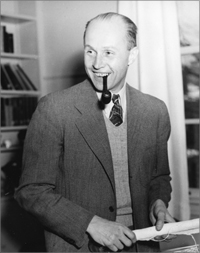George Kistiakowsky (1900-1982) was a Ukrainian-American physical chemist.
He joined the Manhattan Project in late January 1944, leaving his role as chief of the National Defense Research Committee’s Explosives Division. He replaced Seth Neddermeyer as head of X (Explosives) Division and by spring 1945 had over 600 people working on solving the complicated problem of igniting the plutonium core in the atomic bomb. Under Kistiakowsky’s leadership, the complex explosive lenses that would uniformly compress the plutonium sphere to achieve critical mass were developed.
Scientific Contributions
Kistiakowsky fought in the anti-Communist White Army’s infantry and tank corps during the Russian Revolution. After the Bolshevik victory, Kistiakowsky fled to Germany, where he began to study at the University of Berlin in 1921. He received a PhD in chemistry in 1925, then moved to the United States the next year and taught at Princeton as an International Education Board Fellow. In 1930 he joined the faculty at Harvard as a chemistry professor. While teaching at Harvard throughout the 1930s, Kistiakowsky applied his expertise in thermodynamics, spectroscopy, and chemical kinetics to military research, corporate consulting, and political advising.
After World War II, Kistiakowsky returned to teach at Harvard. He was named to President Eisenhower’s Presidential Science Advisory Committee and became Special Assistant to the President for Science and Technology in 1959. To protest the war in Vietnam, Kistiakowsky broke ties with the Pentagon in 1968. Throughout the 1960s and 70s Kistiakowsky spent extensive time working with the National Academy of Science’s Committee on Science, Engineering, and Public Policy.





